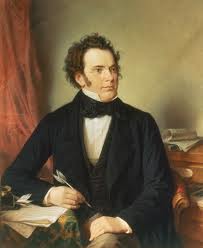Schubert composed his Symphony No. 8 (“Unfinished”) in 1822 and kept it a deep secret for the rest of his life. Even after the composer’s death in 1828, the premiere of the symphony had to wait an additional 37 years until 1865 when it was performed in Vienna under the direction of Johann Herbeck.
The two-movement structure of the “Unfinished” Symphony has raised many questions and debates during the past 150 years. All resulting theories and assumptions have their strong and weak points. Some of today’s theorists have concluded that Schubert in fact completed the work by writing what is known today as the First entr’acte of the incidental music to “Rosamunde”. This theory is based on the fact that both symphony and entr’acte are in the key of B minor, a fairly rare key for a symphony even in the beginning of the nineteenth century. A second argument supporting the ‘Rosamunde’ theory is that at the time he composed the symphony, Schubert had to complete, in a very short time, some incidental music. According to the theory, Schubert sacrificed the finale of his symphony in order to secure his income.
A second theory as to why the composer did not write a third and fourth movement for his most famous instrumental work is based on a very simple and purely aesthetic observation: these two movements say everything the composer had to say. In his book Schubert: A Musical Portrait, Alfred Einstein argues that “He [Schubert] had already written too much that was “finished,” to be able to content himself with anything less or with anything more trivial.”
The first movement begins with an introduction, based on an 8-measure motive, which although not having the status of an independent theme, plays a significant role in the unfolding of the first movement. The themes of the sonata allegro are of a rich singing quality and each complements rather than contrasts with the other. This is a movement in which the romantic intensity is masterfully mixed with tender lyricism. The movement ends in darkness and pessimism: the opening motive is broken to short segments without gravity and without hope.
After the intensity and the dramatic force of the first movement, the second movement presents even more imaginative compositional and melodic structure. Here we have virtually everything the listener can desire to hear in a romantic work – almost “lied”-quality melodies, heroic frescoes, explosive climaxes, and sudden harmonic shifts.
Symphony No. 8 in B Minor
"Unfinished," D. 759
Composed in 1822
By Franz Schubert






